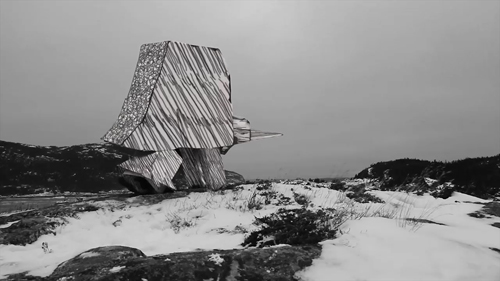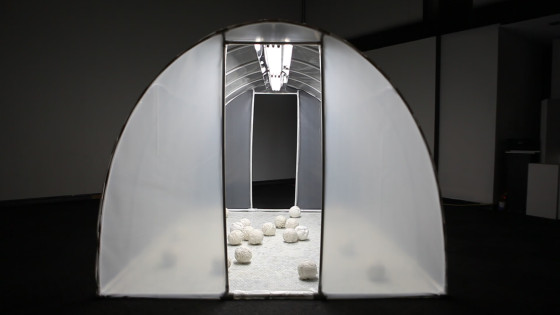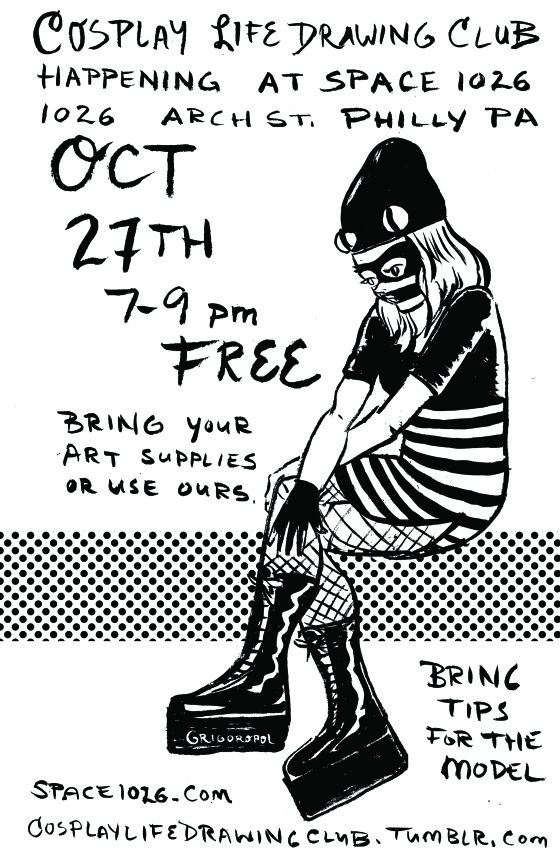12.18 2016
Marissa Paternoster: Solo Exhibition Opening Friday, January 6, 2017
Marissa Paternoster
“The Artist Need Not Suffer”
January 6 – 27, 2017
First Friday Opening Reception: Friday, January 6, 7pm – 10pm
Space 1026 is excited to present a solo exhibition of Marissa Paternoster’s artwork!
Dear World,
Marissa Paternoster was born very small in Elizabeth, NJ. She grew slightly larger over the ensuing years, during which she went to college in a drug haze, learned guitar strums, ate many eggs (not all at once), and finally moved in with wonderful friends and a perfect dog in Philadelphia.
With these works she asks, “WHY MUST THE ARTIST SUFFER?” Must the artist suffer? Maybe the artist can just chill out and have a good time. We may never know what is possible in art. But Marissa is, at this very moment, not suffering.
She is napping.
By Dawn Riddle
Space 1026
1026 Arch Street, 2nd Floor
Philadelphia, PA 19107
12.02 2016
2016 Space 1026 Art Auction
Auction Friday December 9th
7PM Doors Open at 6pm
First Friday Preview
December 2nd, 7-10pm
11.04 2016
JUSTIN CIPA
Opening Reception: Friday, November 4th, 7pm – 10pm
Space 1026 // 1026 Arch Street
“I have been fascinated with, and have been making art for as long as I can remember. What used to be stringent, detailed drawings -for the first thirty years of my life- has been freed into sloppy, mutant distillations of my racing mind.
The evolution of my style was partially born from finally having sympathy for the strained muscles in my hand; moving the action into the greater part of the arm. This allowed me to more wrecklessly and more comfortably apply (or reduce) a stroke. My current process is also the result of learning to create a dialogue between me, my tools and mediums, and time. Sometimes these conversations are long and argumentative and sometimes they are short and funny. Basically, every now and then I look down, my hands are a mess, and I feel pretty fulfilled.
Day-to-day I am interested in dynamics and nuances of all things: The imperfections on a flat surface, complex minimalism, and other paradoxes. Mentally cataloging these experiences and wonderment allows me to later hide the clues to these ideas in my artwork for the observer to discover for themselves. Also, a little humor doesn’t hurt.”
Justin Cipa was born in 1980 near Pittsburgh, PA. He has lived in Philadelphia, PA since 1999 and continues to do graphic design and illustration as well as painting and sculpture.
08.30 2016
Summery
Opening September 2, 2016
1026 Arch Street 2nd Floor
7pm
A collection of drawings, prints, and paintings by New Orleans based artist Max Seckel. Works explore themes of repetition and observation, creating visual puzzles in a variety of media. Inspired by thunderstorms, bouncy balls, the night sky, bicycles, cold beer, sidewalks, long days, shiny objects, wet grass, bright colors, and strong wind.
Seckel is a graduate from the University of Delaware, an early FOB holder at Second State Press, and was a Space 1026 member from 2010-2013. He currently lives and works in New Orleans, Louisiana where he is a regular volunteer at the New Orleans Community Printshop and Darkroom.
06.27 2016
bruja! BRUJA – Friday July 1st
Al San Valentin is honored to have new work created and displayed at Space 1026. bruja! BRUJA. examines the dualistic nature of opposites. Influenced on personal and artistic levels by the writings of Pema Chödron and Alan Watts, they became interested in the concept of opposites as balanced equals. The result is a collection of work that applies this concept to personal history as it defines one’s identity, San Valentin started from their own racial and gender identities yet constructed work that should not be read as autobiographical. Rather, the images can be applied to others’ personal lives as well as our collective experience in this existence.
The works themselves experienced duality in the creation process. The structured nature of screen printed pattern is broken down by a call-and-response kind of mark-making as opposed to calculated moves. Blocks of flat color meld and contrast with defined line drawings. Mass is given to small images through repetition. These screen printed fabric pieces co-exist with black ink illustrations on white paper.
San Valentin sees these works as the beginning, just barely reconciling the systems in our lives that contain two opposite yet equal parts. To recognize the opposites in oneself and accept the need for both parts in order for either to exist. To summon the ghosts of one’s past- the faults and successes, the joys and sorrows- and work with them, allowing oneself to be softened by the ache of their presence.
Al San Valentin lives and works in Philadelphia. They work at a local arts-based preschool, where the uninhibited matter in which children create art is a major influence on their work. San Valentin constantly seeks to return to that moment in life where the path between the image in the mind and the pencil in the hand is gloriously unbroken.
05.19 2016
Philadelphia 2076: Opening June 3rd, 7-10pm
Philadelphia 2076
Opening June 3rd 7-10pm
June 3- 25 2016
Artists: Katie Barrett, Molly Bernstein, Kim Beury, Alana Bograd, Karli Cox, Jonathan DeDecker, Gabe Felice, Keith Greiman, Emily Guendelsberger, Austin Hodges, Olivia Jia, Terri Fry Kasuba, Amy Lee Ketchum & Joshua Ketchum, Tyler Kline, Hawk Krall, Krista Dedrick Lai, Tony Lugo, Molly Metz, Gamil Nassar, Peter Oravetz, Matthew Ostroff, Sonia Petruse, Cait Porter, Catherine Rahman, Melanie Serkes, Sophie Strachan, Heather Sundquist, Tyler Teran, Anthony Torcasio, Jason Andrew Turner, Michael Weaver, Michael Yoder, YOMI.
Space 1026 presents Philadelphia 2076. This open call asked artists to take a look at our city’s future. Asking for loose interpretations of what Philadelphia will look like in the year 2076. For example; post-apocalyptic nightmares, environmental meltdowns, dreamlike futurescapes, new versions of the same old. The response to the call was varied in media and subject matter. Optimistic, depressing, funny, graphic, painterly, and abstract describe the variety of work chosen for this exhibition.The jurors Conrad Benner, Ryan Beck, and Miriam Singer selected photographs, drawings, paintings, and prints for this exhibition.
Artwork is available to view and purchase on our online store.
Artwork on our postcard is by Terri Fry Kasuba
Jurors
Conrad Benner, Founder and Editor of StreetsDept.com, a Philly-based photo-blog that documents and celebrates street art, graffiti, and urban exploration in and around the city of Philadelphia. https://streetsdept.com
Ryan Beck, A Philadelphia based artist whose paintings have muted and watery tones with defined marks and vibrant colors and has shown at Paradigms, James Oliver Gallery, Space 1026, Gallery 222. www.ryanbeckart.tumblr.com
Miriam Singer: creates abstract cityscapes and colorful cartographical drawings inspired by walking around Philadelphia. Exhibitions include Rowan University Gallery, LG Tripp Gallery, Woodmere Art Museum. Miriam currently teaches at Fleisher Art Memorial and is a member of Space 1026 www.miriamsinger.net
#philadelphia2076
03.30 2016
Drop Ceiling

Opening Reception Friday April 1 from 7pm to 10pm
Space 1026 is pleased to present Drop Ceiling, an exhibition of new animation, sculpture, and printed matter by Philadelphia artists Jacob Rivkin and Joshua Zerangue, on view from April 1—April 30, 2016.

To retrofit a structure is to fold time and progress. A drop ceiling, as a whole, functions by simultaneously conforming to and concealing the inner layers of a building through a system of standardized parts. If damaged by water, smoke, or mold—these long tiles can be easily swapped out by new ones. The drop ceiling is just as it was. When working on a damaged boat, wooden ship-builders claim as long as they keep one plank of wood from the old form in the new, then by proxy it is still the same boat. This process of doubling forms serves as a conceptual framework for the exhibition Drop Ceiling, where questioning the role of subsequent translations of meaning is paramount. Rivkin and Zerangue’s collective works examine distance, in both measured time and imaginary space, between the literal and figurative parts of language, narrative, and cinema.
Zerangue’s works symbolically and metaphorically obscure the interrelationships between sources by appropriating letters and symbols, motor parts, and text. By selecting source material, like a 1976 Puch 2-stroke engine repair manual, that has passed through several layers of translation (linguistically, temporally, and spatially), the larger cultural and historical implications of distance between viewer and original meaning become entangled and confused.
Rivkin’s animation forms a dialogue between digital and analog cinema to reconcile methods of creating wonder. The limited color palette of Rivkin’s animation emphasises both the subtle collapsed space, or joins, between the separate layers of hand-drawn animation and the dramatic intensity of the surrounding landscapes. This is juxtaposed in the installation by the chroma-key suits for future animation performances. These suits reveal, through their form the potential for playful gestures and unique movement, a connection to the animator’s close partnership to dance and choreography.
Each work embodies its own individual sense of rhythm, structure, and time–as they also reflect a deeper contemplation on the role of analog technologies within an increasingly digital world. Through converting three dimensional sculpture to animation and embedding digital video into a flip book, Rivkin and Zerangue’s works invite viewers to reexamine their own drop ceiling of engagement to the world of mediated information, objects, and images.
Jacob Rivkin’s animation work has screened at the Animation Block Party in Brooklyn, NY, Vox Populi in Philadelphia, PA, and the Peephole Cinema in San Francisco. His sculptures have been exhibited at the Vancouver Art Gallery in Vancouver, BC, the Arlington Art Center in Arlington, VA and Julius Caesar Gallery in Chicago, IL. He is the recipient of a Fulbright Grant and the Weitzel Barber Travel Prize. He currently teaches animation and design courses at the University of Pennsylvania.
Joshua Zerangue’s animation work has screened at the Brooklyn Film Festival in Brooklyn, NY, Athens International Film Festival in Athens, OH, the Columbia Museum of Art, Columbia, SC, and at the Second Annual New Media Juried Exhibition, Asheville Art Museum, Asheville, NC. He currently teaches art and design courses at the University of Delaware and Drexel University.
02.23 2016
PLEASE COME IN
March 4th – March 27th, 2016

Opening Friday, March 4th 7pm – 10pm
PLEASE COME IN is conceived as a porous environment, in which visitors weave across boundaries between the work of art and the surrounding space, penetrate immersive interiors, and transgress frames. Featuring five artists – Keenan Bennett, Stephanie Elden, Olivia Jones, Daria McMeans, and Yue Nakayama – the exhibition is a web of things that alternately enclose the viewer and open onto their environment.
In her essay “Too Much World: Is the Internet Dead?” artist and critic Hito Steyerl writes that “cinema has exploded into the world to become partly real.” In PLEASE COME IN, artists figure this explosion via screens that surround and interrogate as agents; surreal objects that make room for the viewer or impose themselves on lived space; and constructed environments that are brief alternatives to or escapes from apparent reality. While not all of the artists work directly with cinematic media, the featured videos, sculptural objects, and immersive installations all explore the confused distinction between our lives and their mediations.
Keenan Bennett’s research-based practice explores a nexus of concerns that include marginalized histories, monumentality, and youth subcultures. His immersive multimedia installations trace the cracks and silences of history and toy with the affects of absence and lack. Dense plays of light and shadow, symbolic imagery, and perceptual effects animate Bennett’s mythical, unlocatable situations.
Stephanie Elden’s “hoop house” characterizes her artistic trajectory, which foregrounds both the complex relationships and the innate tensions between natural and unnatural elements. In Elden’s artwork, manufactured space highlights dialectical processes between the artificiality of manmade materials and the organic fluidity of water.
Olivia Jones utilizes fabrics, wood, and steel, mining the aesthetic registers of industrial design and abstract art, to create works of art that fluidly combine architecture, sculpture, and painting. Jones’s alluringly tactile and formally rigorous objects unsettle their own visual appeal through odd contortions that evoke the uncanny.
Combining a minimal aesthetic with a near-documentary approach, Daria McMeans blends film’s stylistic classifications and opens up new relational modes by training the camera on herself and her own family. McMeans’s enveloping three channel installation provokes a range of emotions – from empathy to discomfort – as it mobilizes personal experiences and explores the possibility of conversations about race and lineage.
Yue Nakayama devises her visual literature based on her personal writings about politics, recurring ordinary or historical events, and mass media. Her images and performances are full of humor, an important trait in Nakayama’s art: firstly as an iconoclastic mechanism that challenges taboos against entertainment in contemporary art, and secondly as a disavowal of excessively deadpan topics.
PLEASE COME IN is the third exhibition in the Incubation Series, a curatorial collaboration between graduate students in the Fine Arts and History of Art programs at the University of Pennsylvania. The Incubation Series takes its name from the idea that graduate school is a laboratory where one can test out new ways of thinking. Fostered by Keenan Bennett, Haely Chang, Kirsten Gill, and Hilary R. Whitham, the program aims to simultaneously raise the profile of Penn Design’s MFA candidates by showcasing their work to a wider Philadelphia area audience, while also offering an opportunity for art history graduate students to expand their curatorial practices.
 EXPANDED DIMENSIONS
EXPANDED DIMENSIONS
